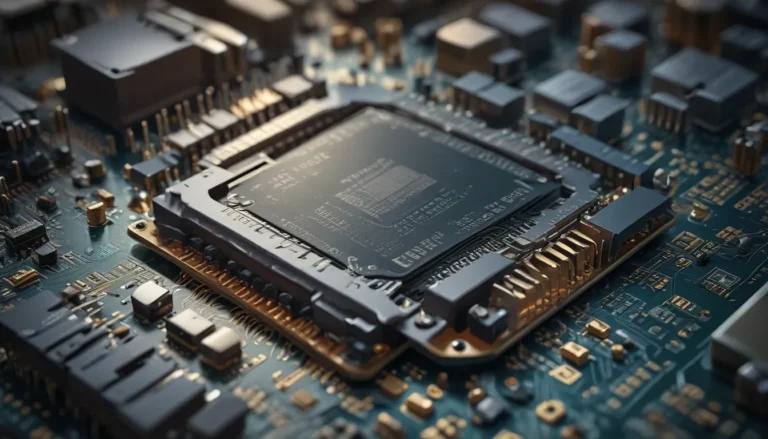A Note About Images: The images used in our articles are for illustration purposes only and may not exactly match the content. They are meant to engage readers, but the text should be relied upon for accurate information.
Are you curious about the science behind dielectric materials and their impact on our daily lives? Dive into the fascinating world of dielectrics and uncover 9 intriguing facts that will broaden your understanding of these essential components in modern technology.
Delving into Dielectric Materials
Dielectric materials are integral to electronic devices, serving as insulators and energy storers. They come in various types, each with distinctive properties and applications. Understanding key factors such as dielectric constant, breakdown voltage, and frequency dependence is crucial for maintaining the safe and reliable operation of electronic systems.
The Essence of Dielectric Material
What exactly are dielectric materials? These substances play a pivotal role in electronics by inhibiting the flow of electric current while enabling the storage and transmission of electrical energy. Capacitors, insulators, and dielectric resonators all rely on the unique properties of dielectric materials to perform their functions effectively.
Exploring the Varieties of Dielectric Materials
From ceramic to polymer to liquid dielectrics, the world of dielectric materials offers a diverse array of options, each tailored to specific applications. Ceramic dielectrics boast a high dielectric constant, while polymer dielectrics offer flexibility and minimal dielectric loss. Choosing the right type of dielectric material is crucial for optimal performance in electronic systems.
Unraveling the Mystery of Dielectric Constant
The dielectric constant, also known as relative permittivity, quantifies a material’s ability to store electrical energy in an electric field. Variations in dielectric constant among different materials can significantly influence the functionality of electronic devices, underscoring the importance of selecting the appropriate dielectric material for specific applications.
Safeguarding with Insulating Properties
Dielectric materials are prized for their insulating properties, serving as indispensable barriers that prevent electrical current from flowing between conductive components. This insulation is vital for safeguarding electronic systems against short circuits and electrical leakage, ensuring their reliable and secure operation.
Navigating Breakdown Voltage
A pivotal parameter of dielectric materials, breakdown voltage denotes the maximum voltage a material can endure before succumbing to electrical breakdown. Opting for a dielectric material with a high breakdown voltage is paramount for averting electrical failures and maintaining the integrity of electronic systems.
Harnessing Dielectric Strength
Dielectric strength measures a material’s ability to withstand the application of an electric field without succumbing to electrical breakdown. Materials endowed with high dielectric strength are particularly desirable for use in high-voltage applications where resilience to electrical stress is paramount.
Embracing Frequency Dependence
Certain dielectric materials exhibit frequency-dependent behavior, known as dielectric dispersion, whereby their properties vary with changing frequencies. This phenomenon can be harnessed in applications such as signal filtering and energy storage, where precise tuning of dielectric responses to varying frequencies is essential.
Mitigating Dielectric Loss
Dielectric loss, or dissipation factor, gauges the extent to which electrical energy is dissipated as heat when an alternating current traverses a dielectric material. Minimizing dielectric loss is crucial for reducing energy wastage in electronic devices and preserving signal integrity, underscoring the significance of low dielectric loss in dielectric materials.
Perils of Dielectric Breakdown
Dielectric breakdown denotes the failure of a dielectric material under high electric field conditions, leading to irreversible damage and loss of insulating properties. Understanding the limits and properties of dielectric materials is paramount in avoiding dielectric breakdown and safeguarding the functionality of electronic systems.
In conclusion, the realm of dielectric materials is replete with potential and significance across a myriad of industries. From enhancing energy storage efficiency to facilitating advancements in electronic devices, dielectrics continue to shape and revolutionize modern technology. By delving into the captivating facts about dielectric materials, we deepen our appreciation for their role in driving innovation and progress in diverse fields.
FAQ
- What is a dielectric material?
-
A dielectric material is an insulating substance capable of storing and supporting an electric charge, essential for separating conductors and regulating electrical energy flow in electrical and electronic systems.
-
What are some common examples of dielectric materials?
-
Common dielectric materials include ceramics like porcelain and mica, polymers such as plastics and rubber, and even gases like air and nitrogen, all pivotal for insulation and energy storage in various applications.
-
What are the primary properties of dielectric materials?
-
Dielectric materials possess the ability to store electrical energy, exhibit high resistivity, low conductivity, minimal energy loss, and high breakdown strength, making them ideal for capacitors, insulators, and electrical insulation.
-
How are dielectric materials utilized in capacitors?
-
Dielectric materials in capacitors aid in separating conductive plates and storing electrical charge, thereby enhancing capacitance values and thwarting current flow between plates for efficient energy storage.
-
Are dielectric materials exclusive to electrical applications?
-
Beyond electrical systems, dielectric materials find utility in medical devices like ultrasound machines, telecommunication equipment, optical fibers, and aerospace technologies, showcasing their versatility across industries.
-
Can dielectric materials be enhanced through engineering modifications?
-
By leveraging techniques like doping, impurity addition, and nanoscale structuring, dielectric materials can be tailored and improved in properties like dielectric constant and breakdown strength, opening avenues for diverse applications.
-
Is recycling possible for dielectric materials?
-
Certain dielectric materials, including select plastics and ceramics, are recyclable. Proper handling and disposal practices must be observed, particularly for materials containing toxic substances, to ensure responsible management.
-
What challenges or limitations exist with dielectric materials?
-
Despite their advantages, dielectric materials confront limitations such as restricted breakdown strength, temperature constraints, and the exigency of precise material selection based on specific application demands.
-
Are ongoing research and developments prevalent in dielectric materials?
- Yes, active research and development endeavors in the realm of dielectric materials persist. Scientists and engineers continue to explore novel materials with enhanced properties, discern applications in emerging technologies, and innovate manufacturing approaches to elevate dielectric performance.
Witness the impact of dielectric materials unfold in the tapestry of modern technology, shaping our world with their intrinsic properties and versatile applications. As we embrace the allure of dielectrics, we embrace a realm brimming with possibilities for advancement and innovation in diverse sectors. Let the journey into the realm of dielectric materials ignite your curiosity and appreciation for the science behind these indispensable components of our technological landscape.






